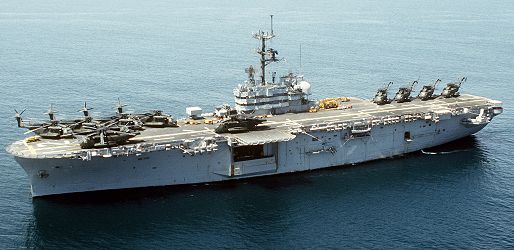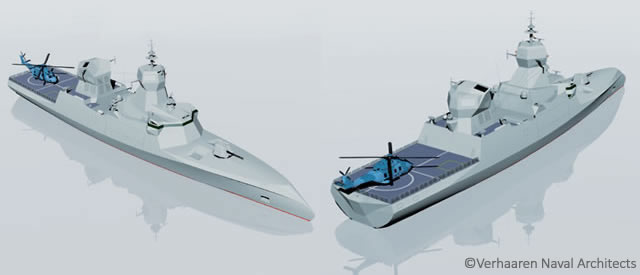IAFM - Fleet Architecture (Battle Force 2045 Edition)
Table of Contents
- Introduction
- Fleet Architecture
- Key Concepts
- Bimodal Presence and Maneuver Forces
- New Task Force Types
- Ship Types
Aviation
The IAFM has a LOT of carriers, 32 to be exact. It can get away with this by ditching both the medium-sized LHAs and LHDs and the very expensive, nuclear powered CVNs.
"CV55"
The primary carrier is a ~70-80,000t, conventional, CTOL carrier designed around carrying roughly 55 aircraft (hence the name, CV55). In contrast, the current, nuclear-powered, Nimitz and Ford classes which are designed to carry roughly 75 aircraft.
Two examples of ships in this range,
 |
| French PA2 |
 |
| CV 63 Kitty Hawk |
The first in class costs for the CV55 is estimated at $8.5 billion. This estimate comes from a briefing on the CVN(X) and LHA(R) Analysis of Alternatives with the following slide:
From there, the total cost for a CV55 is around 63% that of a "CVN75". If the Ford-class CVN75 costs around $12.9 billion, then a notional CV55 would cost a bit more than $8 billion.
CVL-150
The IAFM second carrier is a small, 15-20,000t STOVL carrier. It's designed to carry around 12-16 F-35Bs, or a mixture of helicopters, UAVs and F-35Bs. It harkens back to the Sea Control Ship concept, with the Spanish Príncipe de Asturias as a reasonable approximation.
_during_Dragon_Hammer_92.jpg/1280px-SNS_Principe_de_Asturias_(R11)_during_Dragon_Hammer_92.jpg) |
| Spanish Príncipe de Asturias |
It's hull, propulsion and core systems are based on the common Surface Combatant 150 (SC-150) family of ships to save costs.
Both carriers can double as Landing Platform Helicopter ships (LPH). This obviates the need for separate classes of big-deck amphibious ships in the IAFM.
Admittedly, carriers operating in this swing role won't be as effective as purpose-built amphibious ships, though you can put a lot of Marine or Army aviation on a big-deck carrier. The CVL-150 is roughly the size of an Iwo Jima-class LPH. However, neither is designed with a well deck, and they are not expected carry significant amounts of Marine or Army equipment.
 |
| USS Iwo Jima (LPH 2) |
 |
| USS America (CV66) carrying US Army Special Forces |
I expect in practice, given the number of carriers and the Marine's push for smaller, more distributed operations, mixed air wings of Navy and Marine aircraft may predominate most deployments.
Subsurface Combatants
50 SSNs and 50 SSKs compose the attack submarines in the IAFM.
SSN
The IAFM continues development of the Virginia-class SSN but eliminates the Virginia Payload Module. This module adds a half billion to the price of each sub. For the IAFM, I'd rather have more subs than more VLS cells. The IAFM over-compensates with significant numbers of frigate arsenal ships (FMG-150).
SSBN
Only 10 SSBNs are included. This should permit 4-5 to be on station at any time.
SSK
The SSKs are roughly equivalent to the new, enhanced Soryu-class in the JMSDF, the Taigei-class. They do NOT use Air Independent Propulsion (AIP). Instead they rely on a larger stack of advanced lithium-ion batteries. This gives the Taigei-class far more available submerged power before they have to recharge their cells.
Most SSKs would be forward based in the Pacific to reduce transit times and increase operational availability. Some would be held back in the US to form "aggressor" teams for ASW training.
Large Combatants
The IAFM's three large surface combatant classes and the CVL-150 are based on a common, 15,000-20,000t, Surface Combatant 150 (SC-150) design and family of systems. The CG is a AMD cruiser with a large AMDR radar. The FPD is a hybrid LPD with well deck and guided-missile frigate systems taken from the FFG(X). The FMG is an arsenal ship with the same guided-missile frigate capabilities. These hybrid ships allow the IAMF to retain a significant number of escort-capable vessels while still offering the unique capabilities of LPD- and arsenal ship-style vessels.
 |
| SC-150 Family of Vessels |
Small Combatants
Littoral Combat Corvette (LCK)
The LCK is a "Littoral Combat Corvette" in the 2-3,000t range. Emphasis on long range and endurance, as well as shallow draft, over speed. The C Sword 90 is an example.
These ships would be forward based around areas such as the Persian Gulf, the South China Sea, the Baltic Sea, in areas close to land.
Constellation-class FFG
The FFG is the forthcoming FFG(X) Constellation-class frigate. This ship will be used to develop and prove systems like SPY-6(V)3 EASR and COMBATSS-21 which will be carried forward as the primary combat systems of the FMG-150, FPD-150 and CVL-150 classes.
 |
| Constellation-class FFG (Fincantieri image) |
Medium Displacement Optionally-Manned Vessel (MDOMV)
The MDOMV is an optionally-manned USV somewhat larger than the Sea Hunter MDUSV, with the ability to carry a small crew (10-20). The Thales TX Ship Concept is my current favorite in this category, but one of the fast crew vessels the Navy is investigating may also be suitable. The optional crew provides more resilience in the case of system failures and allows the MDOMV to be used as a patrol vessel as well as MIW, ASW and ISR, when so configured.
These MDOMVs should have sufficient range and speed to operate with task forces and should be able to replenish at sea, when crewed.
Logistics and Auxiliaries
Mine Countermeasures
 |
| MHS-1 |
Offensive Mine Warfare
Global Fleet Station
Amphibious Assault
 |
| Damen LST-120 & notional LST-130 |















Comments